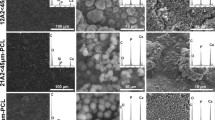Abstract
The osteoconduction potential of artificial materials is usually evaluated in vitro by apatite formation in a simulated body fluid (SBF) proposed by Kokubo and his colleagues. This paper reports the compositional dependence of apatite formation on organic–inorganic hybrids in the CaO–SiO2–PO5/2–poly(tetramethylene oxide) system, initiated from tetraethoxysilane (TEOS), triethyl phosphate (OP(OEt)3), calcium chloride (CaCl2) and poly(tetramethylene oxide)(PTMO) modified with alkoxysilane. Formation of an apatite layer was observed on the surface of the organic–inorganic hybrids with molar ratios of TEOS/OP(OEt)3 ranging from 100/0 to 20/80. The rate of apatite formation remarkably decreased when the hybrids were synthesized with TEOS/OP(OEt)3 ratios of 40/60 or less. Hybrids without TEOS showed no apatite formation in SBF for up to 14 days. Addition of small amounts of OP(OEt)3 to TEOS in the hybrids led to the high dissolution of calcium and silicate, while addition of large amounts of OP(OEt)3 decreased the dissolution of calcium and silicate ions and resulted in reduced apatite formation regardless of the dissolution of phosphate ions from the hybrids.








Similar content being viewed by others
References
Hench LL, Splinter RJ, Allen WC, Greenlee TK. Bonding mechanisms at the interface of ceramic prosthetic materials. J Biomed Mater Res Symp. 1971;2:17–41.
Kokubo T. Recent progress in glass-based materials for biomedical applications. J Ceram Soc Japan (Seramikkusu Ronbunshi). 1991;99:965–73.
Hench LL. Bioactive materials: the potential for tissue regeneration. J Biomed Mater Res. 1998;41:511–8.
Kim H-M. Ceramic bioactivity and related biomimetic strategy. Curr Opin Solid State Mater. 2003;7:289–99.
Ohtsuki C, Miyazaki T, Kamitakahara M, Tanihara M. Design of novel bioactive materials through organic modification of calcium silicate. J Eur Ceram Soc. 2007;27:1527–33.
Ohtsuki C, Kokubo T, Takasyka K, Yamamuro T. Compositional dependence of bioactivity of glasses in the system CaO–SiO2–P2O5: its in vitro evaluation. J Ceram Soc Japan (Seramikkusu Ronbunshi). 1991;99:1–6.
Cho S-B, Nakanishi K, Kokubo T, Soga N, Ohtsuki C, Nakamura T, et al. Dependence of apatite formation on silica gel on its structure: effect of heat treatment. J Am Ceram Soc. 1995;78:1769–74.
Kokubo T, Takadama H. How useful is SBF in predicting in vivo bone bioactivity? Biomaterials. 2006;27:2907–15.
Li R, Clark AE, Hench LL. An investigation of bioactive glass powders by sol–gel processing. J Appl Biomater. 1991;2:231–9.
Miyata N, Fuke K, Chen Q, Kawashita M, Kokubo T, Nakamura T. Apatite-forming ability and mechanical properties of PTMO-modified CaO–SiO2 hybrids prepared by sol–gel processing: effect of CaO and PTMO contents. Biomaterials. 2002;23:3033–40.
Koh M-Y, Kawachi G, Kikuta K, Kamitakahara M, Ohtsuki C. Synthesis of organic–inorganic hybrids of poly(tetramethylene oxide)-calcium silicate and in vitro evaluation of their bioactivity. J Ceram Soc Japan. 2007;115:732–7.
Brennan AB, Miller TM. Structure/property behavior of organic–inorganic SEMI-IPNS. Mater Res Soc Symp Proc. 1996;435:155–64.
Ohtsuki C, Kokubo T, Yamamuro T. Mechanism of apatite formation on CaO–SiO2–P2O5 glasses in a simulated body fluid. J Non-Cryst Solids. 1992;143:84–92.
Zhong J, Greenspan DC. Processing and properties of sol–gel bioactive glasses. J Biomed Mater Res. 2000;53:694–701.
Neuman W, Neuman M. The chemical dynamics of bone mineral. University of Chicago Press; 1958.
Acknowledgement
M.-Y. Koh appreciates financial support from the Japan Society for the Promotion of Science for Young Scientists.
Author information
Authors and Affiliations
Corresponding author
Rights and permissions
About this article
Cite this article
Koh, MY., Kamitakahara, M., Kim, I.Y. et al. In vitro apatite formation on organic–inorganic hybrids in the CaO–SiO2–PO5/2–poly(tetramethylene oxide) system. J Mater Sci: Mater Med 21, 385–392 (2010). https://doi.org/10.1007/s10856-009-3868-0
Received:
Accepted:
Published:
Issue Date:
DOI: https://doi.org/10.1007/s10856-009-3868-0




